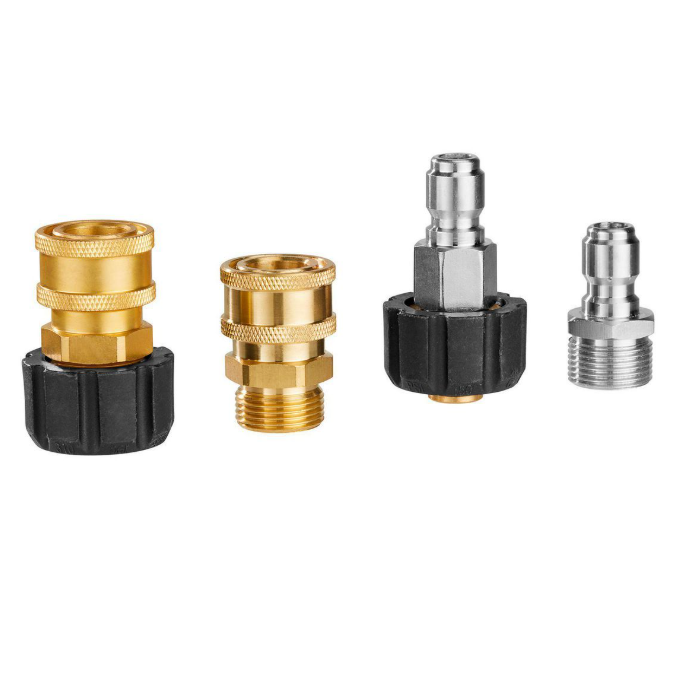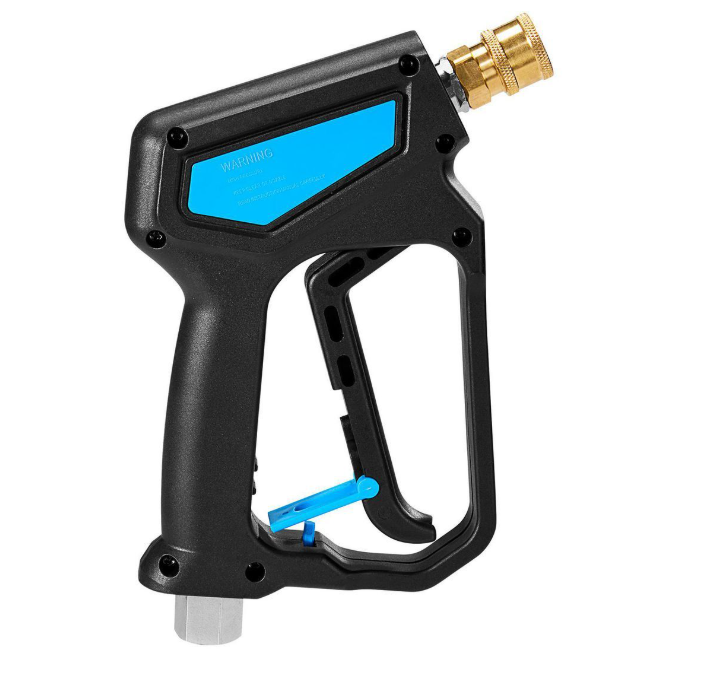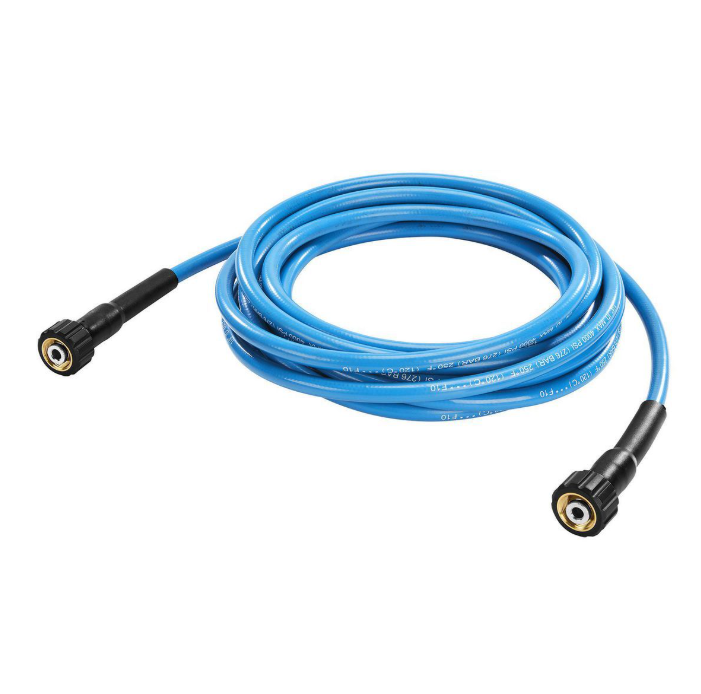
Pressure Washer Turbo Nozzle
- For use with gas and electric pressure washers up to 3200 PSI
- Cleans up to 50% faster than a standard nozzle
- Faster and deeper cleaning with an oscillating jet

Pressure Washer Quick Connect Set, 4-Piece
- Premium stainless steel and brass connection for long life and durability
- M22-14 mm connection fits most gas and electric washers
- Heavy duty O-rings prevent leaking

Pressure Washer Stubby Spray Gun
- Works with gas and electric pressure washers up to 5000 PSI
- Safety locking handle prevents accidental sprays and reduces hand fatigue
- Premium brass and stainless steel construction prevents rust and leaking

25 ft., 4000 PSI Kink-Resistant Pressure Washer Hose
- Kink and memory-resistant, prevents tangles
- Abrasion, cut, chemical, and UV-resistant for maximum durability and hose life
- Lightweight construction weighs less than traditional pressure washer hoses
Keeping Your Cleaning Machine in Prime Condition
When your trusty Bauer pressure washer starts to show signs of wear and tear, knowing where to find reliable replacement parts can save you both time and money. Whether you’re dealing with a leaky hose, a damaged spray wand, or a failing pump, this comprehensive guide will walk you through everything you need to know about Bauer pressure washer parts.
As a proud owner of a Bauer pressure washer myself, I’ve navigated the sometimes confusing world of replacement parts over the years. I’m excited to share what I’ve learned to help you keep your machine running at its best for years to come.
Common Replacement Parts for Bauer Pressure Washers
Let’s face it – even the most durable pressure washers will eventually need some TLC. Understanding which parts commonly need replacement can help you prepare for the inevitable wear and tear.
Pressure Hoses
The high-pressure hose is one of the most frequently replaced components. Constant exposure to high pressure, dragging across rough surfaces, and environmental factors can lead to cracks, leaks, or reduced flexibility. The quality of your pressure washer hose directly impacts your cleaning efficiency and overall experience.
I learned this lesson the hard way after my original Bauer hose developed a pinhole leak after about two years of regular use. That tiny leak reduced my pressure significantly before I even identified the problem!
Spray Wands and Lances
The spray wand (sometimes called a lance) extends your reach and controls the water flow. These can crack if dropped on hard surfaces or develop leaks where they connect to the trigger gun. Many users find themselves needing a replacement after accidental damage.
Trigger Guns
Trigger guns control the water flow from your machine to the spray wand. The internal valve mechanism can wear out over time, leading to leaks or difficulty controlling the spray. This is especially true if you frequently use your pressure washer in harsh conditions.
Nozzles and Tips
Nozzles determine the spray pattern and intensity. They can become clogged with debris or wear out from use, especially if you’re working with hard water. Different cleaning tasks require different nozzle types, so having a complete set of functioning nozzles is essential.
O-rings and Seals
These small rubber components create watertight seals throughout your pressure washer. Over time, they can dry out, crack, or become damaged, leading to leaks and pressure loss. Keeping spare O-rings on hand is always a good idea – they’re inexpensive but critically important.
Pumps
The pump is the heart of your pressure washer. While Bauer pumps are generally reliable, they can eventually fail, especially if the machine isn’t properly maintained or is frequently used for heavy-duty cleaning. Signs of pump failure include unusual noises, significant pressure loss, or oil/water leaks.
Detergent Tanks
These plastic containers hold cleaning solution for jobs that need more than just water power. They can crack or the connection points can fail, especially after exposure to harsh chemicals or UV light.
Wheels
Though not a common failure point, wheels can crack or become damaged, particularly if you regularly move your pressure washer across rough terrain. Having functioning wheels makes your machine much more portable and convenient to use.
Where to Find Bauer Pressure Washer Parts
One of the most common questions I hear is: “Where can I actually buy replacement parts for my Bauer pressure washer?” This is a valid concern, as Bauer is a Harbor Freight brand, which means parts aren’t as widely available as some other brands.
Harbor Freight Stores
Your first stop should be Harbor Freight, the exclusive retailer of Bauer tools and equipment. Many Harbor Freight locations keep common replacement parts in stock, particularly items like nozzles, O-rings, and sometimes hoses. I’ve found that visiting the store in person often yields better results than checking online, as the website doesn’t always reflect in-store inventory accurately.
Harbor Freight Website
The official Harbor Freight website offers some Bauer replacement parts, though the selection can be limited. Check the “Parts & Accessories” section under pressure washers to see what’s currently available. I recommend calling your local store to confirm availability before making a special trip.
Customer Service
If you can’t find the part you need in stores or online, Harbor Freight’s customer service department may be able to help. They can sometimes order parts that aren’t regularly stocked or direct you to appropriate third-party alternatives. Have your model number ready when you call to expedite the process.
Third-Party Retailers
Several online retailers specialize in pressure washer parts that are compatible with various brands, including Bauer. Websites like Amazon, eBay, and specialty pressure washer parts suppliers often carry generic components that will work with your Bauer machine.
Universal Replacement Parts
Many pressure washer parts follow standard sizing and connection types, making universal replacement parts a viable option. This is especially true for items like nozzles, which often use standard connections across different brands.
Official vs. Third-Party Parts: Making the Right Choice
When it comes to replacing parts on your Bauer pressure washer, you have two main options: official Bauer components or third-party alternatives. Let’s weigh the pros and cons of each approach.
Official Bauer Parts
Bauer does provide some replacement parts for their pressure washers, though availability can be inconsistent. The advantages of using official parts include:
- Perfect fit and compatibility
- Potentially longer lifespan
- Maintaining warranty coverage (if applicable)
- Consistent performance with original specifications
The downside is that official parts can sometimes be more expensive or difficult to find, especially for older models.
Third-Party Alternatives
Third-party replacement parts are often more readily available and may offer cost savings. Many users find that:
- Generic parts are more affordable
- There’s a wider selection of options
- They may offer improvements over original parts
- They’re easier to find when you need them quickly
However, quality can vary significantly between manufacturers, and fit isn’t always perfect. Some trial and error might be involved in finding reliable third-party suppliers.
From my experience, I’ve had good luck with third-party hoses and nozzles, but I prefer to use official parts for critical components like pumps when possible. The hose I purchased from a pressure washer specialty store has actually lasted longer than my original Bauer hose.
The Cost Factor: Budgeting for Replacement Parts
Replacement parts vary widely in cost, depending on what you need. Here’s a general breakdown of what you might expect to pay:
- Nozzles and tips: $5-20 each
- O-rings and seals: $5-15 for assortment packs
- Pressure hoses: $30-70 depending on length and quality
- Trigger guns: $20-40
- Spray wands: $15-30
- Pumps: $70-150 (the most expensive component)
- Detergent tanks: $15-25
- Wheels: $10-20 each
Keep in mind that prices can fluctuate, and sales or discounts may be available. I’ve found that investing in higher-quality components for frequently used items (like hoses) often pays off in the long run, even if the initial cost is higher.
How to Replace Common Bauer Pressure Washer Parts
Now that we know what parts might need replacing and where to find them, let’s walk through some common replacement procedures. While specific steps may vary slightly depending on your exact model, these general guidelines should help you tackle most repairs.
Replacing the Pressure Hose
The pressure hose is one of the most commonly replaced parts and fortunately one of the easiest to swap out. Here’s how to do it:
- Make sure your pressure washer is turned off and disconnected from both power and water sources.
- Release any remaining pressure by squeezing the trigger gun.
- Unscrew the old hose from both the pump outlet and the trigger gun. You may need wrenches for this, but be careful not to overtighten.
- Apply thread seal tape to the connections on your new hose if it doesn’t come with seals installed.
- Connect the new hose to the pump outlet and tighten by hand first, then give a slight extra turn with a wrench.
- Connect the other end to your trigger gun and tighten securely.
- Test for leaks by reconnecting the water supply and turning on the machine momentarily.
I recommend applying a small amount of thread lubricant to make future removal easier, especially if you store your pressure washer in a humid environment where connections might corrode.
Replacing Nozzles
Nozzles are quick and easy to replace:
- Ensure the pressure washer is off and depressurized.
- Pull back the quick-connect collar on the spray wand.
- Remove the old nozzle.
- Insert the new nozzle and release the collar.
- Pull on the nozzle to ensure it’s securely attached.
Most Bauer pressure washers use standard quick-connect nozzles, making replacements relatively straightforward. If you’re unsure about compatibility, taking your old nozzle to the store for comparison is always a safe bet.
Replacing the Trigger Gun
When your trigger gun starts leaking or becomes difficult to operate, here’s how to replace it:
- Turn off and depressurize your pressure washer.
- Disconnect the spray wand from the gun.
- Disconnect the high-pressure hose from the gun.
- Connect the high-pressure hose to your new trigger gun.
- Attach the spray wand to the new trigger gun.
- Test for proper operation and check for leaks.
Some trigger guns come with built-in spray wands, while others use separate components. Make sure you’re purchasing the correct type for your setup.
Replacing O-Rings and Seals
O-rings and seals are critical for preventing leaks:
- Identify the leaking connection points.
- Turn off and depressurize the system.
- Disconnect the leaking connection.
- Remove the old O-ring or seal (small picks can help with removal).
- Clean the seating surface thoroughly.
- Apply a light coating of silicone lubricant to the new O-ring.
- Install the new O-ring and reassemble the connection.
- Test for leaks.
I keep an assortment of common O-ring sizes in my garage for quick repairs. This has saved me numerous trips to the store over the years.
Replacing the Pump
Pump replacement is more complex and might require professional help, but here’s the general process:
- Disconnect all power and water sources.
- Remove the housing that covers the pump (if applicable).
- Disconnect the high-pressure hose, garden hose inlet, and any bypass hoses.
- Remove the bolts that secure the pump to the engine or motor.
- Note the position of the pump relative to the drive shaft.
- Carefully remove the old pump.
- Install the new pump in the same orientation.
- Reattach all bolts, hoses, and connections.
- Test run the machine at low pressure first.
This is definitely the most technical repair on the list. If you’re not comfortable with mechanical work, this might be a job for a professional.
Nozzle Compatibility and Types
Nozzles are relatively inexpensive but critically important to your pressure washer’s functionality. Understanding nozzle compatibility and types can dramatically improve your pressure washing results and prevent damage to surfaces.
Are Bauer Nozzles Interchangeable?
Most Bauer pressure washers use standard quick-connect nozzles with a 1/4-inch connection. This means that nozzles from other brands with the same connection type will typically work with your Bauer machine. This standardization is good news when you’re looking for replacements or specialty nozzles not offered by Bauer.
Common Nozzle Types
Nozzles are typically color-coded to indicate the spray angle:
- Red (0°): Provides a concentrated pinpoint spray for tough stains but can damage surfaces if used incorrectly.
- Yellow (15°): Offers an intense cleaning pattern for stubborn dirt while covering more area than the red tip.
- Green (25°): Provides general-purpose cleaning for most surfaces – this is what I use most often for driveways and siding.
- White (40°): Creates a wider spray pattern that’s gentler on surfaces, ideal for vehicles, windows, and fragile surfaces.
- Black (soap): Has larger openings that reduce pressure and allow for detergent application.
Some pressure washers also come with a turbo or rotary nozzle that combines the cleaning power of a narrow-angle tip with the coverage of a wider-angle spray by rapidly rotating the water stream.
Specialty Nozzles Worth Considering
Beyond the standard nozzles, several specialty options can enhance your Bauer pressure washer’s capabilities:
- Surface cleaners: These attachment systems use multiple nozzles under a dome to clean large flat surfaces quickly and evenly.
- Foam cannons: These create thick foam for vehicle washing and other applications requiring extended soap contact time.
- Extension wands: While not technically nozzles, these can extend your reach for cleaning second-story siding or other high areas.
I personally invested in a surface cleaner attachment after struggling to clean my large driveway with standard nozzles. It cut my cleaning time by more than half and produced more consistent results.
Hose Sizing and Extensions
The standard hose that comes with most Bauer pressure washers is typically 25 feet long. If you find yourself constantly stretching to reach cleaning areas, you might consider upgrading to a longer hose or adding an extension.
What Size Hose Fits Bauer Pressure Washers?
Most Bauer pressure washers use standard M22 threaded connections with a 14mm internal diameter. When purchasing a replacement or extension hose, look for:
- M22 connections (most common)
- Appropriate PSI rating (matching or exceeding your machine’s maximum PSI)
- Desired length (typically available in 25, 50, or 100-foot options)
- Flexibility (more flexible hoses are easier to manage)
Can I Use a Longer Hose?
Yes, you can use a longer hose with your Bauer pressure washer, but there are some important considerations:
- Pressure Loss: For every additional 50 feet of hose, you may experience approximately 10-15% pressure loss due to friction.
- Maximum Length: Most consumer-grade pressure washers like Bauer work best with hoses under 100 feet total length.
- Hose Quality: Higher-quality hoses with smooth internal walls will experience less pressure loss than lower-quality options.
If you need significant additional length, consider using a high-quality extension hose rather than replacing your original hose with an extremely long one. This gives you flexibility to use the shorter hose when appropriate.
Maintenance Kits and Preventative Care
While Bauer doesn’t offer comprehensive maintenance kits specifically for their pressure washers, creating your own kit of commonly needed parts is a smart strategy.
DIY Maintenance Kit Components
Consider keeping these items on hand for quick repairs:
- Assorted O-rings and seals
- Pump oil (if your model uses oil)
- Thread seal tape
- Silicone lubricant
- A set of replacement nozzles
- Basic wrenches sized for your connections
Performing regular maintenance can significantly extend the life of your Bauer pressure washer and reduce the need for parts replacement.
Preventative Maintenance Tips
To minimize part failures and extend the life of your pressure washer:
- Always release pressure before storage
- Never run the pump dry (without water)
- Use a water filter to prevent debris from entering the pump
- Store your machine in a climate-controlled environment when possible
- Winterize properly if you live in cold climates
- Run clean water through the system after using soap
- Inspect hoses and connections regularly for early signs of wear
I make it a habit to run a quick inspection before and after each use. This quick check has helped me catch minor issues before they became major problems.
Troubleshooting: Identifying the Parts You Need
Sometimes the hardest part of repairing your pressure washer is figuring out exactly what component needs replacing. Here are some common symptoms and the likely culprits:
Low Pressure or Pressure Fluctuations
- Clogged nozzle (try cleaning before replacing)
- Worn nozzle (look for enlarged or irregular spray pattern)
- Leaking hose or connections (check for visible leaks or moisture)
- Worn pump components (listen for unusual noises)
- Intake valve issues (check water supply and filter)
Leaks
- From connections: Likely worn O-rings or loose fittings
- From the pump body: Possible seal failure within the pump
- From the trigger gun: Internal valve issues in the gun
- From the hose: Pinhole leaks or damaged connector ends
No Detergent Flow
- Clogged detergent filter
- Damaged detergent tank
- Incorrect nozzle (only the black soap nozzle typically draws detergent)
- Blocked detergent line
Machine Won’t Start
- Electrical issues (check power source and connections)
- Pump seized (may need replacement)
- Thermal overload protection activated (allow to cool)
When troubleshooting, isolate components by disconnecting and testing them individually when possible. For example, to test if a nozzle is clogged, remove it and see if water flows freely without it.
Finding Parts Diagrams and Manuals
Having access to parts diagrams and service manuals can make identifying and ordering the correct components much easier.
Harbor Freight Resources
Harbor Freight typically includes a basic parts diagram in the manual that comes with your pressure washer. If you’ve lost your manual, you can often download a PDF version from the Harbor Freight website by searching for your model number.
Online Communities
Several online forums and communities focus on tool repair and maintenance. These can be valuable resources for identifying parts when official documentation is limited. Websites like:
- Tool discussion forums
- Reddit communities focused on tools and DIY
- YouTube channels dedicated to tool repair and maintenance
I’ve found extremely helpful information on specialized forums where other Bauer owners share their experiences and repair tips.
When to Replace vs. When to Upgrade
Sometimes a component failure offers an opportunity not just to replace a part but to upgrade your pressure washing capabilities.
Consider Upgrading When:
- Your hose is damaged (opportunity to get a longer or more flexible option)
- Your trigger gun fails (chance to upgrade to one with more features)
- You need new nozzles (consider adding specialty nozzles for specific tasks)
- Your pressure washer is aging (evaluate repair costs versus replacement)
Consider Simple Replacement When:
- The machine is relatively new
- The part is inexpensive
- You’re satisfied with the original performance
- The repair is straightforward
I took the opportunity to upgrade to a more ergonomic trigger gun with a built-in pressure gauge when my original gun developed a leak. This small upgrade significantly improved my pressure washing experience.
Real-World Experiences with Bauer Parts
I’ve owned my Bauer pressure washer for over three years now, and I’ve replaced several parts during that time. My experiences might help you anticipate what to expect:
The original hose lasted about two years of regular use before developing leaks. I replaced it with a third-party 50-foot hose that has proven more durable than the original.
O-rings tend to need replacement annually, especially if you disconnect your hoses frequently. Keeping a variety pack on hand is definitely worthwhile.
Nozzles can last for years if you’re careful to avoid dropping them on hard surfaces and store them properly. I keep mine in a small plastic case to prevent damage.
My trigger gun needed replacement after about 2.5 years. The internal valve began to leak, causing pressure fluctuations. The upgraded replacement has actually performed better than the original.
Final Thoughts on Bauer Pressure Washer Parts
Maintaining your Bauer pressure washer doesn’t have to be daunting or expensive. With a bit of knowledge about common replacement parts and where to find them, you can keep your machine running efficiently for years to come.
Regular maintenance and prompt replacement of worn components are the keys to extending the life of your pressure washer and getting the most value from your investment.
Whether you choose official Bauer parts or compatible alternatives, the important thing is to address issues promptly before they lead to more significant problems. Small leaks can progress to pump damage, and worn nozzles can reduce your cleaning efficiency dramatically.
By familiarizing yourself with your machine’s components and keeping a few essential spare parts on hand, you’ll be prepared to handle most common issues quickly and get back to your cleaning projects without extended downtime.
Remember that pressure washers are hardworking machines that operate under extreme conditions. Even with the best care, parts will eventually wear out. When they do, you now have the knowledge to identify, source, and replace them confidently.
Happy pressure washing!

